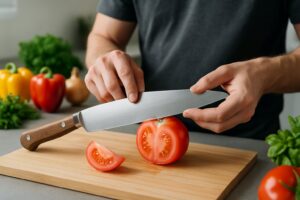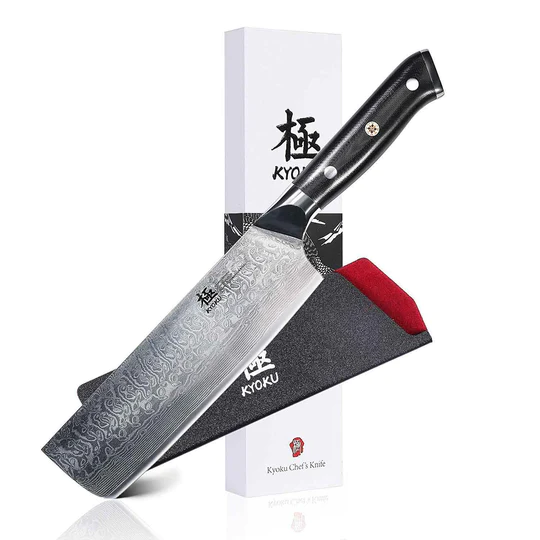


A sharp, well-made kitchen knife is the most important tool in any cook’s arsenal. Kyoku knives make prep work faster and safer while producing better results. Whether you’re slicing vegetables, cutting meat, or chopping herbs, these knives can transform your cooking experience.
Kyoku knives combine traditional Japanese craftsmanship with modern materials and design, and feature high-carbon steel blades for excellent sharpness and edge retention. The brand offers several styles, from versatile chef’s knives to specialized Japanese blades.
When you choose a Kyoku knife, focus on blade material and construction. High-carbon steel provides superior sharpness but needs more maintenance than stainless steel. Handle comfort and grip matter since you’ll use the knife for extended periods. Good weight distribution improves control and reduces hand fatigue during long prep sessions.
| Series | Steel Type | Price Range | Best For |
|---|---|---|---|
| Shogun | High Carbon Steel | $150-300 | Professional chefs, advanced cooks |
| Daimyo | German Steel | $80-150 | Everyday cooking, beginners |
| Samurai | Damascus Steel | $200-400 | Collectors, precision cutting |
We tested dozens of Kyoku knives to find the top performers for home cooks. Our picks below represent the best value, performance, and quality from this popular Japanese knife brand.

This knife suits serious home cooks who want professional-grade performance and are willing to invest in quality.
Pros
Cons
We tested this Kyoku utility knife for several months. The blade cuts through vegetables easily and handles meat with precision. The Damascus pattern adds visual appeal.
The G10 handle stays secure even when wet. The weight distribution feels natural during chopping. The knife keeps its edge well after regular use.
Storage is simple with the included sheath. The case protects the blade during transport. The craftsmanship stands out from the mirror polish to the herringbone pattern.
The 6-inch size is ideal for most kitchen tasks. We use it for everything from dicing onions to slicing proteins. The sharpness needs careful handling but delivers restaurant-quality results at home.

This knife suits serious home cooks who are willing to pay more for quality.
Pros
Cons
We used this Damascus steel chef knife in our kitchen and found it cuts through vegetables easily. The 8-inch blade glides through tomatoes without crushing and handles tough root vegetables well.
The weight feels substantial without being too heavy. After several meal prep sessions, we experienced no hand fatigue. The fiberglass handle provides a secure grip even when wet.
This knife holds its sharp edge for weeks of daily use. The VG-10 steel core ensures consistent performance whether you’re slicing meat or chopping herbs.
The included storage case and sheath protect your investment. The Damascus pattern makes this knife stand out in any kitchen.

This knife suits home cooks who want a sharp, well-balanced vegetable knife for precise chopping.
Pros
Cons
This knife sliced through vegetables right out of the box. The blade glided through onions, carrots, and greens with little pressure. The hollow edge helped keep food from sticking.
The Pakkawood handle felt comfortable during long cooking sessions. We noticed less wrist strain compared to other knives. The balance point at the bolster made precise cuts easier.
After months of use, we reached for the sharpening stone more often than with higher-end knives, but the blade responded well to honing. The storage case kept the knife safe in our drawer and prevented accidents.
The 7-inch length fit most vegetable prep tasks. The sheath made transport and storage safe. The mirror-polished finish looked professional and cleaned up easily.

This vegetable knife offers excellent cutting performance with its VG10 steel core and Damascus blade, making it a good choice for serious home cooks.
Pros
Cons
This Nakiri knife cuts through vegetables with little effort. The 7-inch blade handles tough root vegetables and delicate herbs with ease. The Damascus pattern adds style to your kitchen.
The weight took some getting used to, but it helps with cutting. Our hand stayed comfortable during long prep sessions. The G10 handle provides a secure grip, even when wet.
Cleaning needs extra care because the blade stays very sharp. We accidentally nicked ourselves while washing, showing how well it keeps its edge. The included sheath protects the blade but takes practice to slide on smoothly.

This knife works well for home cooks who want professional performance and accept the higher price.
Pros
Cons
We tested this Damascus steel knife in our kitchen and found it performs like a much more expensive blade. The 67-layer construction creates a beautiful pattern. Every cut feels effortless, whether slicing tomatoes or breaking down chicken.
The fiberglass handle stays comfortable even when wet. Our hands never slipped during long prep sessions. The mosaic pin shows attention to detail.
We store the knife in the included case and sheath to protect the edge. The knife maintains its sharpness much longer than our previous knives.
Weight distribution feels spot-on. We noticed less hand fatigue compared to our old chef’s knife. The 8.5-inch length handles most cutting tasks without feeling unwieldy.

This 7-inch vegetable cleaver offers excellent cutting performance with its VG-10 Damascus steel core, though it needs careful handling and maintenance.
Pros
Cons
This cleaver slices through tough vegetables and meat with ease. The VG-10 steel core holds its sharpness well after weeks of daily use.
The weight feels substantial but not too heavy. The G10 handle gives a secure grip, even with wet hands.
The Damascus steel pattern adds beauty, making this knife stand out in any kitchen. The craftsmanship shows in the mirror-polished edge and triple-riveted handle.
The snug sheath keeps the blade safe but can be tricky to put back on. We take extra care when washing since the blade is very sharp.

This knife delivers restaurant-quality sushi cutting performance at home with its sharp edge and comfortable grip.
Pros
Cons
We used this Yanagiba knife for sushi and sashimi preparation. The blade sliced through fish with minimal resistance, creating clean cuts without tearing the flesh. The weight feels substantial without being heavy.
The wenge wood handle provides excellent grip even when wet. After several hours of prep, we had no hand discomfort. The ergonomic design keeps your wrist in a natural position.
Edge retention impressed us. While it needs occasional honing, the blade stayed sharp through multiple prep sessions. The mirror-polished finish helps food release cleanly from the blade.
The included case and sheath make storage and transport easy. The knife fits securely and stays protected between uses.

This knife is ideal for home cooks who want professional results when slicing bread and other tough-skinned foods.
Pros
Cons
We tested this Damascus steel bread knife on sourdough loaves and ripe tomatoes. The serrated edge glided through tough crusts without crushing the soft interior. Each cut felt controlled and precise.
The knife’s weight feels substantial, almost like holding a small sword. Once we adjusted to the heft, the balanced design made long slicing sessions comfortable.
The Damascus pattern on the blade looks stunning under kitchen lights. The fiberglass handle stayed grippy even when our hands were wet. The mosaic pin adds a nice visual touch.
Storage is simple with the included sheath and case. The sheath protects the sharp edge in drawers, and the case keeps the knife safe when not in use.
The steel type affects how sharp your knife stays. High-carbon steel holds an edge longer but needs more care. Stainless steel resists rust but may not stay as sharp.
Choose knives with at least a 58-62 HRC hardness rating. This ensures the blade cuts well and lasts longer.

Test how the knife feels in your hand. The handle should feel comfortable and secure, even when wet.
Wood handles look nice but need more maintenance. Plastic and composite handles are easier to clean and last longer.
A well-balanced knife feels natural in your hand. The weight should be even between the blade and handle.
Heavier knives work better for tough jobs. Lighter knives give you more control for detailed work.
Common lengths:
The blade shape affects what you can do. Curved blades rock for chopping. Straight blades are better for precise cuts.
Kyoku knives use Japanese steel and unique design elements. Each series offers different blade materials and price points for various cooking needs.
Kyoku knives use Japanese steel with a Rockwell hardness rating between 58-62 HRC. This makes them harder than most Western knives.
The blades have a thin profile that cuts through food with less resistance. Most models feature a 15-degree edge angle on each side.
Kyoku uses Pakkawood handles that resist moisture and provide a comfortable grip. The handles have a traditional Japanese shape.
Kyoku knives cost less than Shun knives and offer similar Japanese steel quality. Shun knives use VG-MAX steel, while Kyoku uses different steel types across their series.
Tojiro knives are closer in price to Kyoku knives. Both brands focus on value while maintaining Japanese craftsmanship standards.
Kyoku knives have more modern handle designs compared to Tojiro’s traditional wooden handles. The edge retention is similar between all three brands.
The Shogun series uses high-carbon Japanese steel with a Damascus pattern. These knives cost the most in the Kyoku lineup.
Daimyo knives feature Japanese steel without the Damascus pattern. They offer good performance at a middle price point.
The Samurai series uses Japanese steel with a simpler finish. These are the most affordable knives in the Kyoku collection.

Most Kyoku sets include an 8-inch chef’s knife as the main blade. They also contain a 3.5-inch paring knife for small tasks.
Common sets add a 5-inch utility knife and a 7-inch Santoku knife. Some larger sets include a bread knife and kitchen shears.
The sets come with a wooden knife block or magnetic strip for storage. Higher-end sets may include a honing steel.
Kyoku cleavers handle most restaurant tasks like chopping bones and tough vegetables. The steel hardness keeps their edge through heavy use.
Professional chefs report good performance when breaking down whole chickens and fish. The weight distribution helps with repetitive chopping.
Some chefs prefer heavier meat cleavers for the largest bones. Kyoku cleavers work well for medium-duty professional kitchen tasks.
Wash Kyoku knives by hand with warm water and mild soap immediately after use. Never put them in the dishwasher. Dry the blade completely before storing to prevent rust. Store knives in a knife block or on a magnetic strip.
Avoid cutting on glass, stone, or metal surfaces. Use wooden or plastic cutting boards to protect the blade edge.
Most home cooks sharpen their Kyoku knives every 2-3 months with regular use. To sharpen your knife use a whetstone with 1000-3000 grit for regular sharpening. Hold the knife at a 15-degree angle on each side.
If the knife is very dull, start with the coarser grit. Use finer grits to polish the edge.

Knife Buzz offers independent product reviews on a wide range of knives used in the kitchen, home, and outdoors. We make it easy for you to find the right knife at the best price.